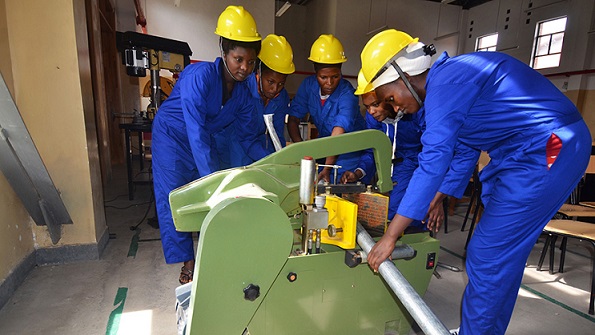Ab initio, technical vocational education and training (TVET) holds the potential to reshape Nigeria’s economic future. As traditional education systems continue to struggle with meeting the demands of an evolving job market, TVET provides an alternative pathway for millions of Nigerian youth to acquire marketable skills, gain employment, and even create jobs. TVET is specifically designed to equip individuals with the technical and vocational skills needed to meet the demands of industries. This form of education is not simply an alternative to higher education; it is a critical tool for economic growth, self-reliance, and poverty alleviation. In Nigeria, where unemployment—especially among the youth—is a growing concern, TVET offers a practical solution to bridge the gap between education and employment.
A key example of TVET’s potential can be seen through the story of Zainab. Raised in Lagos State, Zainab completed her early education at Tukur International Schools and later attended Yaba College of Technology before securing admission to FUTA in 2017. Her academic journey has been a testament to resilience, determination, and technical education. Initially aspiring to study Aeronautical Engineering, Zainab’s financial constraints led her to discover Metallurgical and Materials Engineering. This decision proved pivotal in shaping her future in welding and fabrication. Zainab’s journey into welding began during her Student Industrial Work Experience Scheme (SIWES) days in 2017 while working at a shipyard company in Apapa. Witnessing the intricate welding and fabrication of Fairway Buoys in the marine environment sparked her passion for the profession.
TVET and Unemployment in Nigeria
According to the National Bureau of Statistics, the labour force participation rate among the working-age population remained high at 80.4% in Q2 2023, with an employment-to-population ratio of 77.1%. The combined rate of unemployment and time-related underemployment as a share of the labour force population (LU2) stood at 15.5%. Most workers, around 88%, were self-employed, while only 12% were in wage employment. The unemployment rate rose slightly to 4.2%, up from 4.1% in Q1 2023. Among those with post-secondary education, unemployment was 8%, while youth unemployment (ages 15-24) was 7.2%, up from 6.9% in Q1. The unemployment rate in urban areas also increased, reaching 5.9% from 5.4%. Time-related underemployment was 11.8%, with 8% of the working-age population engaged in subsistence agriculture. The informal employment rate was 92.7%, and the percentage of youth not in employment, education, or training (NEET rate) was 13.8%.
In countries like Germany, TVET programmes have been instrumental in maintaining low unemployment rates and supporting industries with skilled labour. Similarly, African nations such as Rwanda and South Africa have embraced TVET, establishing training centres and developing partnerships with industries. These countries have demonstrated that TVET is not just a fallback option but a viable and strategic choice for sustainable economic growth.
While TVET’s potential is immense, Nigeria faces significant challenges in fully realising its benefits. These include outdated curricula that do not align with workplace needs, underfunding, inadequate infrastructure, and a lack of qualified instructors. Additionally, the stigma surrounding vocational training persists, as university education is often seen as the more prestigious route to success.
The Nigerian government, alongside institutions such as the National Board for Technical Education (NBTE), must focus on addressing these challenges. There is a pressing need for:
1. Modern, well-equipped training centres: Investments in infrastructure and equipment will ensure students receive hands-on experience in line with industry standards.
2. Curriculum reform: Aligning TVET curricula with the current and future needs of the job market will make graduates more employable and competitive.
3. Public-private partnerships: collaborating with industries to provide internships, apprenticeships, and job placements will enhance students’ learning experiences and increase their employment prospects.
4. Teacher training and motivation: Investing in the training of TVET educators and providing them with adequate incentives will ensure that students receive quality instruction.
TVET’s role in Nigeria’s future cannot be overstated. It offers an adaptable and efficient approach to building a skilled workforce, addressing youth unemployment, and fostering entrepreneurship. As Nigeria seeks to diversify its economy and reduce its reliance on oil, the demand for skilled workers across sectors such as manufacturing, agriculture, and IT will grow. TVET is the vehicle that will drive this transformation. Embracing TVET as a strategic educational path, Nigeria can unlock its full economic potential. The country must now focus on destigmatising vocational education and making it an attractive option for young Nigerians. TVET is not just an alternative to higher education—it is the key to empowering individuals like Funmi to become innovators, job creators, and the backbone of Nigeria’s economic growth. Conclusion: To ensure that TVET reaches its full potential in Nigeria, significant investments must be made in infrastructure, curriculum reform, and partnerships with the private sector. Public awareness campaigns can also help change the narrative around vocational training, presenting it as a prestigious and viable option for personal and national growth.
Ultimately, TVET is more than just a form of education; it is a catalyst for change. With a stronger focus on vocational education, Nigeria can better prepare its youth for the demands of the modern job market, reduce unemployment, and unlock a brighter economic future for all.











